
Statues along the road to Angkor Thom. (487k)
In February 2003 I visited Southeast Asia for the first time. After a two week vacation in Việt Nam I spent three days in Siem Reap in Kâmpuchéa (Cambodia) to visit the temples of Angkor Wat, Angkor Thom, and several others. They are impressive to say the least. The Angkor is a UNESCO World Heritage Site.
Siem Reap contains the remnants of one of the many Ancient Civilizations that I saw during my travels.
The first temple complex we visited was Angkor Thom. There you see many of the four-faced towers that are so well known. It is the largest of the temples in the area. It was built in the late 12th/early 13th century by Jayavarman VII.
Next stop was Ta Prohm. This is the one temple complex where the jungle was not cleared. All the temple complexes were completely overgrown by jungle for quite some time. Only in the late 19th century, when the French made it known world-wide, was it cleared from the jungle. In Ta Prohm, some of the jungle is left and it creates impressive sights with huge trees growing on top of the temple walls.
After this, it was Angkor Wat, the most famous of the temple complexes. Angkor Wat was built in the early 12th century by Suryavarman II to honor the Hindu God Vishnu.
All around the perimeter of this complex is a wall covered with stone bas-reliefs. It is a continuous bas-relief telling stories about wars between peoples, wars between Gods and demons, and between people and demons. The total length is about 800 m (2,620 ft). It is a fabulous sight.
One interesting aspect of Angkor Wat is the fact that the stairs at the top are incredibly steep. They go up at an angle of about 60°. Going up was not too difficult, but going down with my fear of heights was a little disconcerting.
After this we visited some of the oldest temples, Pre Rup and Bakong, Bakong was built in the late 9th century by Indravarman I, Pre Rup was built in the 10th century by Rajendravarman II. It is amazing that temples this old are still in decent shape. The oldest temples were built from brick, with the doors and other carvings made from sandstone.
The most amazing carvings are in Banteay Srei. This temple was built in the late 10th century by Jayavarman V. The carvings, many of them three dimensional, are very well preserved. They are absolutely spectacular. It is only a small temple, but for me it was the most amazing one of all of the temples.
The UNESCO website for Angkor Wat, Angkor has some interesting information and links.
In one of the temples a religious ceremony was taking place. A medium was preparing to do a séance and go into a trance. The temples are still used for current religious purposes.
We did see some other things besides the temples. One excursion was to Kbal Spean and the 1000 Shiva Lingam. Carved in the rocky bed of a small river are over a thousand Shiva Lingam symbols. The Shiva Lingams are square pedestals with a grove, symbolizing the female sex organ, and a phallic symbol in the center (see Shiva Lingam).
One afternoon we took a boat onto Tonlé Sap Lake, a large lake about 100 km (60 miles) long. On that lake is a floating village of Việt Namese emigrants. They have everything on houseboats, including a church. Vendors move around the floating village on boats laden with groceries and everything else you need. All transportation there is of course on boats, so you can see all types of boats.
In Siem Reap we watched a traditional dance show. It seemed to be very similar to Thai dancing. It was quite interesting to see.
One visit was to a school for disadvantaged village children. They come to this school and learn crafts like wood carving and stone carving. It is good to see that such efforts exist.
Most of the houses in the area around Siem Reap are on stilts. It seems that the area is flooded frequently. When I was there it was the dry season. People there don't do any irrigation, so they harvest only one crop of rice (as opposed to Việt Nam, where they harvest two or three crops of rice with irrigation).
There is a huge difference between Kâmpuchéa and Việt Nam in the attitude of the people. While in Việt Nam there are no beggars, everybody tries to make an honest living, and everything is clean, in Kâmpuchéa there are beggars everywhere, and everything is filthy. There is garbage everywhere, even around houses where people live. It was pretty sad to see this.
The temples around Siem Reap, with Angkor Wat the center piece, are one of the most impressive sites that I have seen, more so than even Machu Picchu and the Taj Mahal. It is definitely worth a visit.
All pictures are © Dr. Günther Eichhorn, unless otherwise noted.

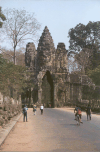
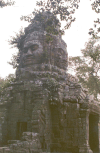
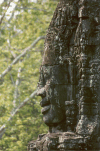
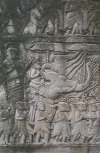


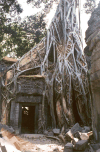


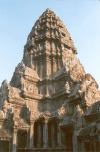
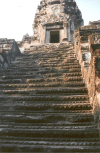




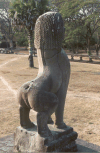

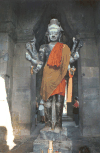
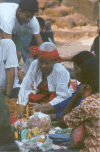
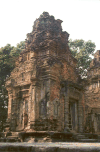

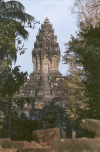

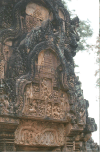
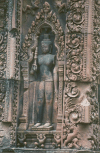
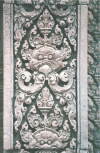


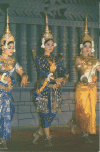
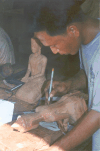







The total number of pictures online on my website from Cambodia is 38
Page last updated on Tue Apr 23 11:22:27 2024 (Mountain Standard Time)
Kâmpuchéa (Cambodia): Siem Reap and its Temples on aerobaticsweb.org